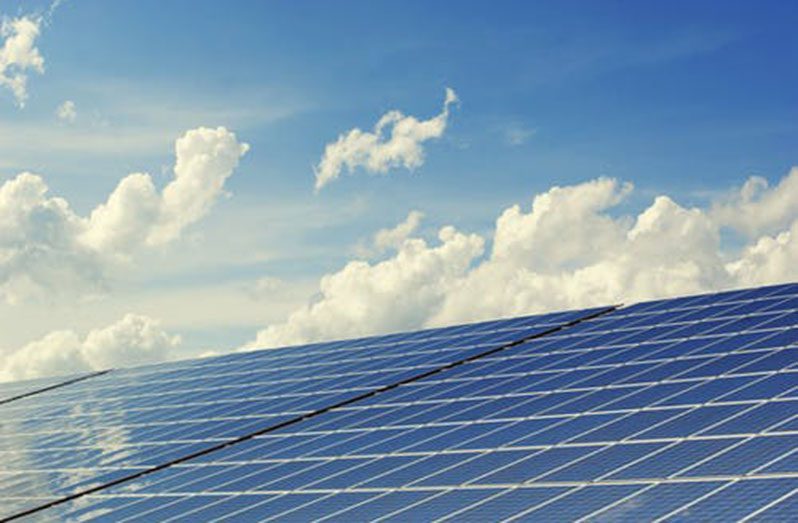GUYANA’S aggressive campaign to have a diversified energy matrix which employs primarily renewable energy resources, has received new impetus with the Inter-American Development Bank’s (IDB) approval of US$83.3 million in non-reimbursable investment financing for the Guyana Utility Scale Solar Photovoltaic Programme (GUYSOL).
Utilising funds from the Norwegian Agency for Development Co-operation, the IDB will contribute directly to eight utility-scale, photovoltaic solar projects totalling 33 megawatts-peak (MWp) with associated 32 megawatts-hour (MWh) energy storage systems distributed across three areas in Guyana.
Specifically, there will be 10MWp in the Berbice area, eight MWp in the Essequibo system with a minimum of 12MWh battery storage and a 15MWp plant connected to the Linden system, with a minimum of 22MWh battery storage.
The eight projects, according to the IDB, will contribute to avoiding CO2 emissions, lowering electricity cost generation, and supporting a substantial transition to generation based on renewable energy sources.
The programme will also support a step-change with respect to digitalisation of the Essequibo and Linden electrical systems, moving them from manual systems towards real-time, automated monitoring and control, improving efficiency, reliability, and stability.
“Alongside of these investments in infrastructure, the GUYSOL Programme will encourage diversity and inclusion in the maintenance and management of renewable infrastructure, developing local skills and apprenticeships with a focus on opportunities for women,” the IDB said.
By 2025, in line with Guyana’s Low Carbon Development Strategy (LCDS), more than 265,000 customers within the Demerara-Berbice Interconnected System, and Linden and Essequibo systems will benefit from reinforced reliability of electricity supply, and modernisation of systems.
The Guyana Power and Light Inc. (GPL) and the Linden Electricity Company Inc. (LECI) will also benefit from the use of solar photovoltaic technology that will displace significant amounts of fossil fuels and reduce generation costs.
“This operation is in line with Vision 2025 – Reinvesting in the Americas: A Decade of Opportunities, created by the IDB to achieve recovery and inclusive growth in Latin America and the Caribbean, in the areas of digital economy, gender and inclusion, and climate change,” the IDB said.
The IDB has been supporting the Government of Guyana to develop the energy sector through financing of several renewable energy activities.
Building on this, the country will now make a transformational leap towards decarbonisation by expediting climate-resilient renewable energy in the electricity generation matrix.
It was reported that Guyana, driven by an energy mix of solar, wind, hydro and natural gas, could soon become a major player in the energy market, and ultimately the energy capital of the Region.
According to the United Nations Development Programme (UNDP), access to modern energy services is fundamental to fulfilling basic social needs, driving economic growth and fuelling human development. This is because energy services have an effect on productivity, health, education, safe water and communication services.
For developing nations such as Guyana, the need for reliable and affordable energy is more fundamental. The general understanding is that reliable energy, in these countries, supports expanded industry, modern agriculture, increased trade and improved transportation.
In Guyana’s context, “energy security,” as said by President Ali during his inaugural address to the 12th Parliament, will be driven by an energy mix that will see solar, wind, hydro and natural gas being utilised to make this nation the energy capital of the Region.
The integration of those energy sources will provide Guyana with 400 megawatts of newly installed power. As it is now, the national grid is providing 120 megawatts of electricity, an amount which is equal to the consumer demand of 117-120 megawatts of power.
Based on what the President had outlined, the potential “world-class” energy mix will not just increase Guyana’s energy capacity, but will also significantly reduce the cost of electricity for households and businesses.
The overarching aim of the new People’s Progressive Party/Civic (PPP/C) government is to reduce the overall cost of energy by 50 per cent through this energy mix. Local capacity aside, President Ali is confident that the government’s plan will make Guyana’s energy costs globally competitive.
Essentially, the country could become a net energy exporter. A net exporter is a country or territory whose value of exported goods is higher than its value of imported goods over a given period of time.
IDB plugs US$83.3M into Guyana’s renewable energy campaign
SHARE THIS ARTICLE :
Facebook
Twitter
WhatsApp




.png)









